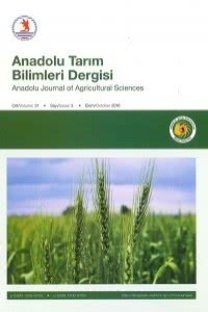Follicular development and superovulatory response in PMSG/anti-PMSG administered cattle
Birinci denemede sığırlarda PMSG uygulamasından sonra azalan dozda anti-PMSG enjeksiyonunun süperovulasyon üzerine olan etkisi araştırılmıştır. İkinci denemede de anti-PMSG'nin folliküler gelişim ve daha sonra süperovulasyon için uygulanan PMSG'ye olan tepkisi üzerindeki etkisi araştırılmıştır. Birinci denemede toplam 24 Hereford x British Frisian inek iki deneme grubuna tesadüf blokları deneme desenine göre ayrılmış ve kızgınlığın 9 ve 10. günlerinde 200 iu PMSG verilmesinden sonra 48. saate PG enjeksiyonu yapılmıştır. PG injeksiyonunda bir gnıba (n=12 inek) 2.2 mi anti-PMSG ve 24 saat sonra 1.1 ml anti-PMSG verilmiştir. Kontrol grubundaki hayvanlara (n=12 inek) ayni zamanlarda ayni miktarlarda kör enjeksiyonlar uygulanmıştır, ikinci denemede toplam 24 baş Hereford x British Frisian düve tesadüf blokları deneme desenine göre 3 gnıba ayrılmışlardır. Birinci grupta, 8 düveye kızgınlık döngüsünün 2. gününden 10. gününe kadar günlük 300 iu anti-PMSG enjekte edilmiştir, ikinci grupta, 8 düveye birinci grupta verilen anti-PMSG'ye ilave olarak 11. günde 1500 iu PMSG verilmiş ve 3. grupta 8 düveye hiçbir muamele (kontrol) uygulanmamıştır. Anti-PMSG'nin azalan dozları (birinci deneme) PMSG'nin süperovulasyon yapıcı etkisini ve follikül gelişimini engellemiştir. Anti-PMSG grubundaki hayvanların %92'sinde (11/12) ovulasyon gerçekleşmemiş ve bir hayvandan sadece bir embriyo elde edilmiştir. Kızgınlık döngüsünün 2. gününden 10. gününe kadar anti-PMSG verilen hayvanlar PMSG'nin süper ovulasyon yapıcı etkisine tepki vermemişlerdir ve sadece kontrol grubu düvelerde beklenen yumurta sayısı üretilmiştir. Sonuç olarak kızgınlık döngüsünün erken lüteal fazında anti-PMSG uygulanması ve kızgınlığı teşvik etmek için PG enjeksiyonundan sonraki anti-PMSG uygulaması, PMSG ile uyarılan sığırlarda süperovulasyonu engellemektedir. Anti-PMSG'nin engelleyici etkisinin endojen gonadotropinlere bağlanmadan daha başka mekanizmalar nedeniyle olduğu görülmektedir.
PMSG ve anti-PMSG uygulanan sığırlarda folliküler gelişim ve süperovulasyona tepkiler
The effect of declining doses of anti-PMSG administered after the gonadotrophin PMSG on superovulatory response in cattle was assessed in experiment 1. The potential of anti-PMSG to suppress follicular development and subsequent response to a superovulatory dose of PMSG was investigated in experiment 2. In experiment 1, a total of 24 Hereford x British Friesian cows were allocated to two treatment groups in a randomised block design and received 2000 i.u. PMSG on day 9 or 10 ,of the oestrous cycle followed by prostaglandin (PG) injection 48 hours later. At PG injection, a group of 12 animals received 2.2 ml anti-PMSG and a further 1.1 ml anti-PMSG 24 h later. Control animals (n=12) received thejsame volume of placebo at the same times. In experiment 2, a total of 24 Hereford x British Friesian maiden heifers were allocated to three treatment groups in a randomised block design; eight animals received 300 i.u. anti-PMSG daily from day 2 to day 10 of oestrous cycle, eight animals received'1500 i.u. PMSG on day .11 following the same anti-PMSG treatment, .and eight animals remained untreated. Declining doses of anti-PMSG (experiment 1) inhibited the superovulatory effect of PMSG and interfered with follicular development. In the anti-PMSG group, 92% (11/12) of animals did not ovulate and a single embryo was recovered from one animal. Animals receiving anti-PMSG from days 2 to 10 of the oestrous cycle (experiment 2) did not respond to a superovulatory dose of PMSG and only produced the number of ova expected from untreated heifers, hi conclusion, administration of anti-PMSG during the early luteal phase of the oestrous cycle and administration of anti-PMSG after the PG injection to induce oestrus inhibits the superovulatory response of PMSG-stimulated cattle. The inhibitory effect of anti-PMSG seems to be due to mechanisms other than cross-reaction with endogenous gonadotrophins.
